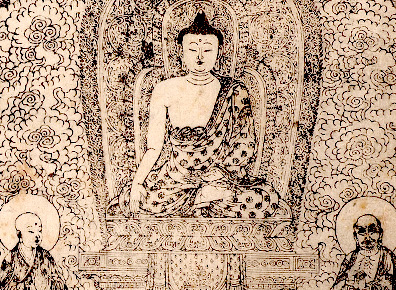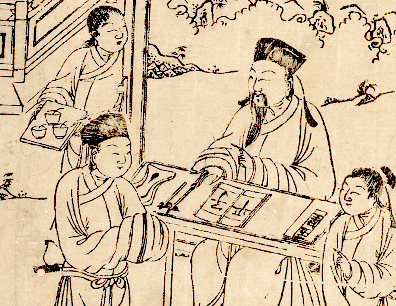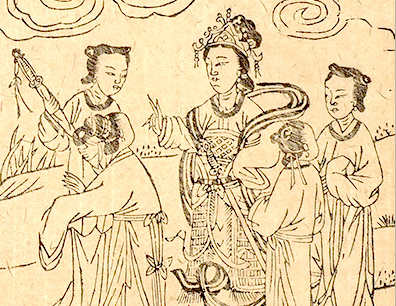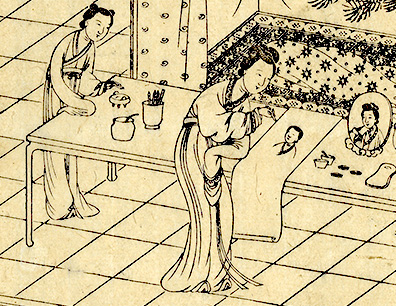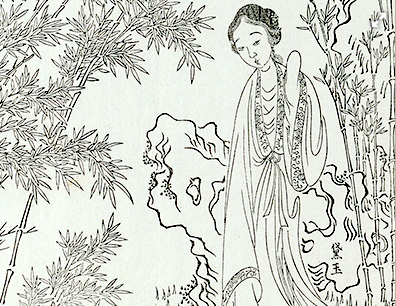The development of Chinese book illustrations by the time of the Ming and Qing dynasties had arrived, prompted by the changes in social milieu and economic growth, at a stage where their aesthetics as marked by thematic diversity and refined techniques was given the uttermost importance, a shift from the stress of the Sung and Yuan dynasties whereas prints were expected to illustrate Confucian and geographical texts and fulfill their instructive and interpretive functions.
The popularity of including printed illustrations in books as an eye-catching feature reached its peak during the Jiajing and Wanli reigns of the Ming dynasty. Driven by the prospect of making business gains, publishing houses would invite famous artists to draw illustrations, and employ expert engravers to transfer the images onto woodblocks, in the hope that the books printed would receive wide circulation and generate profits. The phenomenon of clearly demarcated areas of book printing operation of the Sung and Yuan dynasties continued through the Ming. Various printers competed among themselves and formed different schools. In such book publishing centers as Jianyang, Jinling, Wulin, Huizhou, Wuxing, and Suzhou, many printmaking schools based on techniques passed down from previous generations emerged. However, as the turnover of craftsmen was not uncommon, these individually distinctive schools were mutually influential at the same time.
In early Qing, the authority implemented a stricter policy towards publishing, and the waxing and waning of government and commercial printing became apparent. On one hand, the illustrations in government-commissioned publications were meticulously and rigorously executed, revealing the underlying intent to propagate imperial achievements and to inculcate officials and commoners. On the other, commercial print-ing gradually declined, failing to sustain the publishing boom of the mid-Ming.
Zhufo Shizun Rulai Pusa Zunzhe Shenseng Mingjing
- Sutra of the Names of Buddhas, Bhagavats, Tathagatas, Boddhisatvas, Arhats and Venerable Monks
- Compiled on imperial order of Emperor Chengzu, Ming dynasty
- Imprint of 1417, Yongle reign, Ming Dynasty
The Zhufo Shizun Rulai Pusa Zunzhe Shenseng Mingjing is an imperial Buddhist scripture comprising tens of thousands of Buddha and bodhisattva titles, compiled at the order of the Ming emperor Chengzu. Most Buddhist scriptures from Song and Yuan dynasties are in the form of rolls or accordion bound copies, ideally suited for making long and connected illustrative prints. Thread-bound Buddhist scriptures began to gain popularity in early Ming dynasty and led to a change in the format of Buddhist prints. The triptych preamble of this scripture follows the typical style of a Buddha sermon illustration, similar in composition to prints found in the Qisha Zang of the Yuan dynasty. The central panel features Sakyamuni and his disciples Ananda and Kasyapa. The symmetrical front and back panels contain portraits of eight monks, four bodhisattvas and two maharajahs, representing the four maharajahs, sixteen arhats and eight bodhisattvas who serve the Buddha. The back cover contains, as in the traditional style of Han Chinese scriptures, the portrait of Veda dressed as a general and guarding the Buddha-truth. (Liu Kuo-wei)
Kejingtai Zengbu Yunhaizhipin Daquan
- Supplement to Complete Guide to Ziping’s Fortune-telling Methods
- Written by Li Qin, Ming dynasty
- Imprint of 1600 by Liu Longtian’s Chaoshantang Hall in Fujian, Wanli reign, Ming dynasty
The Kejingtai Zengbu Yunhaizhipin Daquan is a numerology masterpiece from the late Ming dynasty. The title indicates it was supplemented by Li Qin, Head of the Imperial Observatory (or Qintianjian). The work was printed by the Qiaoshan Shushe of Jianning, Fujian, in the 28th year of the Wanli reign (1600). The title is listed in the bibliographic section of “Yiwenzhi (Treatise on Literature)” in the Ming Shi (History of the Ming Dynasty) as Li Qin Yunhaizhipin Daquan Liujuan, and classified under the section for Xingxiang (Astrology) in the category of Wuxing (Five Elements). The book is a supplement to Yuanhai Ziping, a work of numerology from the Sung dynasty, with denotations and additions thereto. It is based on the “Ziping divination doctrine” of Master Xu Ziping (907-960), using the Four Pillars from the year, month, date and time of birth as the Eight Diagrams to foretell a person’s fate. Explanations are given on fundamental principles of the synergy and energy between yin and yang, Five Elements and tiangan and dizhi (the Chinese eras), as well as divination rules based on one’s numerological data. Also included in the volumes are several mnemonic verses, which serve as a shortcut for learning the techniques while adding to the readability and practicality of the book. (Hong Jian-rong)
Xinke Chuxiang Guanban Dazi Xiyou Ji
- Large-print Journey to the West, with Illustrations
- Written by Wu Chengen, Ming dynasty
- Imprint by the Shidetang Hall of Jinling, Wanli reign, Ming dynasty
The Xinke Chuxiang Guanban Dazi Xiyou Ji in the collection of the National Palace Museum includes 100 stories in 20 fascicles. Its provenance and how it entered into the collection are the same as the previous work. It was printed by the Shidetang Hall of Jinling in 1592, and is considered the earliest version of the 100-story Xiyou Ji. Only four copies are in existence worldwide today, including three in Japan and one in the National Palace Museum.
It is marked at the beginning of the book that it was “proofread by Huayang Dongtian Zhuren and printed by the Shidetang Hall of Jinling.” Some volumes bear the mark of “printed by the Rongshoutang Hall of Jinlin.” The researchers of this work have different opinions on this bibliographic discrepancy. Some suggest that the two Halls printed the volumes individually but released the work together; others claimed that the two print houses released the work separately, and a Fujian printer by the name of Xiong Yunbin reprinted it based on the Jinling versions. Nevertheless, the work features cross-page illustrations, with descriptive captions on top. They showcase bold carvings and rugged lines, which are stylistic of the Jinling style of prints.
Mudan Ting Huanhun Ji
- The Peony Pavilion
- Written by Tang Xianzu, Ming dynasty
- Imprint by the Jiuwotang Hall, Wanli reign, Ming dynasty
Mudan Ting Huanhun Ji is an exemplary work by Ming-dynasty opera composer Tang Xianzu (1550-1616). “Of my four reverie-style works, I take the greatest pride in the Peony,” said Tang. The 55-act opera narrates how Du Liniang fell in love with the young scholar Liu Mengmei in a dream and eventually died of her sorrows. Liniang was the only daughter of Du Bao, the Southern Sung prefectural governor of Nanan. Before passing, she sealed and buried her self-portrait underground, which was later uncovered by Liu. She found her way into his dream as a ghost, and was able to resurrect herself to give the love story a happy ending.
The flyleaf of the volume comes with the mark of the Jiuwotang Hall, a private print house from Huaitang, Shexian, Anhui. Although the author of the 40 prints in the book is unknown, they were signed by skilled engravers from the Huang family from Shexian in late Ming dynasty, including Mingqi, Yifeng, Duanfu and Jifu. The carving style reflects a shift in Hui-style wood engraving from rugged and unconstrained lines toward a new focus on exquisite compositions. (Hsu Yuan-ting)
Honloumeng Tuyong
- Dream of the Red Chamber, with Illustrations
- Written by Gai Qi, Qing dynasty
- Illustrated edition of 1879, Guangxu reign, Qing dynasty
The Hongloumeng Tuyong by Gai Qi of the Qing dynasty is the first collection of woodcut prints dedicated exclusively to portraying characters from the novel Hongloumeng. It features 55 characters in 50 illustrations, as well as literary comments by 34 noted figures of the time. Gai Qi (1773-1828) was a poet and painter in mid and late Qing dynasty, renowned for his portraits of female figures. The illustrations found in this book were produced when he lived at the Wuyuan Residence of Li Sunxiang in Cangzhou. The literary comments are reflective of the social network of the noted figures in southern China. The manuscripts were later acquired by Hauipu Jushi, who took them to a print house in 1879.
Characters in the book are mostly made from embroidery, supplemented with representative scenes from the novel. The portraits and themes featured herein demonstrate the artistic quality prevalent in figure paintings of the time. The work was well received after its release. Another imprint by the Wenyuantang Hall released somewhat later was also widely distributed, and it has become very influential for future generations of readers. (Wu Yi-ching)


